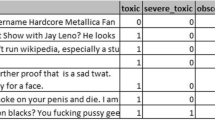Abstract
In the era of social networking platforms, user-generated content is flooding every second on online social media platforms like Facebook. So observing and identifying many contents, including threats and sexual harassment, are more accessible than traditional media. Online content with extreme toxicity can lead to online harassment, profanity, personal attacks, and bullying acts. As Bangla is the seventh most spoken language worldwide, the utilization of Bangla language in Facebook has raised current times. The use of abusive comments on Facebook with Bangla also has increased alarmingly, but the research regarding this is very low. In this research work, we concentrate on identifying abusive comments of Bangla language in social media (Facebook) that can filter out at the primitive stage of social media’s affixing. To classify abusive comments swiftly and precisely, we apply transformer-based deep neural network models. We employ pre-training language architectures, BERT (Bidirectional Encoder Representations from Transformers) and ELECTRA (Efficiency Learning an Encoder that Classifies Token Replacements Accurately). We have conducted this work with a novel dataset comprises 44,001 comments from multitudinous Facebook posts. In this classification process, we have exhibited an average accuracy, precision, recall, and f1-score to evaluate our proposed models. The outcomes have brought a percipience of our applied BERT and ELECTRA architecture that performs notably with 85.00% and 84.92% test accuracy, respectively.







Similar content being viewed by others
Notes
References
Adhikari A, Ram A, Tang R, et al (2019) Docbert: bert for document classification. arXiv preprint arXiv:1904.08398
Ahmed MF, Mahmud Z, Biash ZT, et al (2021a) Bangla text dataset and exploratory analysis for online harassment detection. arXiv preprint arXiv:2102.02478
Ahmed MS, Aurpa TT, Anwar MM (2020a) Online topical clusters detection for top-k trending topics in twitter. In: 2020 IEEE/ACM international conference on advances in social networks analysis and mining (ASONAM), IEEE, pp 573–577
Ahmed MS, Aurpa TT, Anwar MM (2020b) Query oriented topical clusters detection for top-k trending topics in twitter. In: 2020 IEEE 8th R10 humanitarian technology conference (R10-HTC), IEEE, pp 1–6
Ahmed MS, Aurpa TT, Anwar MM (2021) Detecting sentiment dynamics and clusters of twitter users for trending topics in covid-19 pandemic. Plos one 16(8):e0253300
Ahmed MS, Aurpa TT, Azad MAK (2021c) Fish disease detection using image based machine learning technique in aquaculture. J King Saud Univ-Comput Inf Sci
Al-Twairesh N (2021) The evolution of language models applied to emotion analysis of Arabic tweets. Information 12(2):84
Alam MT, Islam MM (2018) Bard: Bangla article classification using a new comprehensive dataset. In: 2018 international conference on bangla speech and language processing (ICBSLP), IEEE, pp 1–5
Alzamzami F, Hoda M, El Saddik A (2020) Light gradient boosting machine for general sentiment classification on short texts: a comparative evaluation. IEEE Access 8:101840–101858
Ashrafi I, Mohammad M, Mauree AS et al (2020) Banner: a cost-sensitive contextualized model for Bangla named entity recognition. IEEE Access 8:58206–58226
Awal MA, Rahman MS, Rabbi J (2018) Detecting abusive comments in discussion threads using Naïve Bayes. In 2018 international conference on innovations in science, engineering and technology (ICISET), IEEE, pp 163–167
Bauer T, Devrim E, Glazunov M, et al (2019) # metoomaastricht: building a chatbot to assist survivors of sexual harassment. In: Joint European conference on machine learning and knowledge discovery in databases, Springer, pp 503–521
Carneiro T, Da Nóbrega RVM, Nepomuceno T et al (2018) Performance analysis of google colaboratory as a tool for accelerating deep learning applications. IEEE Access 6:61677–61685
Chia YK, Witteveen S, Andrews M (2019) Transformer to cnn: Label-scarce distillation for efficient text classification. arXiv preprint arXiv:1909.03508
Clark K, Luong MT, Le QV, et al (2020) Electra: Pre-training text encoders as discriminators rather than generators. arXiv preprint arXiv:2003.10555
Das KA, Baruah A, Barbhuiya FA, et al (2020) Ensemble of electra for profiling fake news spreaders. In: CLEF
Devlin J, Chang MW, Lee K, et al (2018) Bert: Pre-training of deep bidirectional transformers for language understanding. arXiv preprint arXiv:1810.04805
Emon EA, Rahman S, Banarjee J, et al (2019) A deep learning approach to detect abusive bengali text. In: 2019 7th international conference on smart computing and communications (ICSCC), IEEE, pp 1–5
Farha IA, Magdy W (2021) Benchmarking transformer-based language models for arabic sentiment and sarcasm detection. In: Proceedings of the sixth Arabic natural language processing workshop, pp 21–31
Iwendi C, Srivastava G, Khan S, et al (2020) Cyberbullying detection solutions based on deep learning architectures. Multimed Syst:1–14
Janardhana D, Shetty AB, Hegde MN, et al (2021) Abusive comments classification in social media using neural networks. In: International conference on innovative computing and communications, Springer, pp 439–444
Kurnia R, Tangkuman Y, Girsang A (2020) Classification of user comment using word2vec and SVM classifier. Int J Adv Trends Comput Sci Eng 9:643–648
Li X, Bing L, Zhang W, et al (2019) Exploiting bert for end-to-end aspect-based sentiment analysis. arXiv preprint arXiv:1910.00883
Libovickỳ J, Rosa R, Fraser A (2019) How language-neutral is multilingual bert? arXiv preprint arXiv:1911.03310
Nobata C, Tetreault J, Thomas A, et al (2016) Abusive language detection in online user content. In: Proceedings of the 25th international conference on world wide web, pp 145–153
Ostendorff M, Bourgonje P, Berger M, et al (2019) Enriching bert with knowledge graph embeddings for document classification. arXiv preprint arXiv:1909.08402
Ozyurt IB (2020) On the effectiveness of small, discriminatively pre-trained language representation models for biomedical text mining. In: Proceedings of the first workshop on scholarly document processing, pp 104–112
Park JH, Fung P (2017) One-step and two-step classification for abusive language detection on twitter. arXiv preprint arXiv:1706.01206
Pericherla S, Ilavarasan E (20218) Performance analysis of word embeddings for cyberbullying detection. In: IOP conference series: materials science and engineering, IEEEOP Publishing, p 012008
Pires T, Schlinger E, Garrette D (2019) How multilingual is multilingual bert? arXiv preprint arXiv:1906.01502
Rosenberg A, Hirschberg J (2007) V-measure: A conditional entropy-based external cluster evaluation measure. In: Proceedings of the 2007 joint conference on empirical methods in natural language processing and computational natural language learning (EMNLP-CoNLL), pp 410–420
Salminen J, Hopf M, Chowdhury SA et al (2020) Developing an online hate classifier for multiple social media platforms. Human-Cent Comput Inf Sci 10(1):1–34
Salur MU, Aydin I (2020) A novel hybrid deep learning model for sentiment classification. IEEE Access 8:58080–58093
Samad MD, Khounviengxay ND, Witherow MA (2020) Effect of text processing steps on twitter sentiment classification using word embedding. arXiv preprint arXiv:2007.13027
Shukla S, Mittal G, Arya KV, et al (2021) Detecting hostile posts using relational graph convolutional network. arXiv preprint arXiv:2101.03485
Souza F, Nogueira R, Lotufo R (2019) Portuguese named entity recognition using bert-crf. arXiv preprint arXiv:1909.10649
Su J, Yu S, Luo D (2020) Enhancing aspect-based sentiment analysis with capsule network. IEEE Access 8:100551–100561
Tripto NI, Ali ME (2018) Detecting multilabel sentiment and emotions from bangla youtube comments. In: 2018 international conference on Bangla speech and language processing (ICBSLP), IEEE, pp 1–6
Xu H, Liu B, Shu L, et al (2020) Dombert: Domain-oriented language model for aspect-based sentiment analysis. arXiv preprint arXiv:2004.138167
Xue K, Zhou Y, Ma Z, et al (2019) Fine-tuning bert for joint entity and relation extraction in chinese medical text. In: 2019 IEEE International conference on bioinformatics and biomedicine (BIBM), IEEE, pp 892–897
Yadav J, Kumar D, Chauhan D (2020) Cyberbullying detection using pre-trained bert model. In: 2020 International conference on electronics and sustainable communication systems (ICESC), IEEE, pp 1096–1100
Yu J, Jiang J (2019) Adapting bert for target-oriented multimodal sentiment classification. IJCAI
Yu S, Su J, Luo D (2019) Improving bert-based text classification with auxiliary sentence and domain knowledge. IEEE Access 7:176600–176612
Yuan C (2019) Bb-kbqa: Bert-based knowledge base question answering. In: Chinese computational linguistics: 18th China national conference, CCL 2019, Kunming, China, October 18–20, 2019, Proceedings, Springer Nature, p 81
Zhang H, Sun S, Hu Y et al (2020) Sentiment classification for Chinese text based on interactive multitask learning. IEEE Access 8:129626–129635
Zhu Y, Kiros R, Zemel R, et al (2015) Aligning books and movies: Towards story-like visual explanations by watching movies and reading books. In: Proceedings of the IEEE international conference on computer vision, pp 19–27
Author information
Authors and Affiliations
Corresponding author
Additional information
Publisher's Note
Springer Nature remains neutral with regard to jurisdictional claims in published maps and institutional affiliations'' (in PDF at the end of the article below the references; in XML as a back matter article note).
Rifat Sadik and Md Shoaib Ahmed have contributed equally to this work.
Rights and permissions
About this article
Cite this article
Aurpa, T.T., Sadik, R. & Ahmed, M.S. Abusive Bangla comments detection on Facebook using transformer-based deep learning models. Soc. Netw. Anal. Min. 12, 24 (2022). https://doi.org/10.1007/s13278-021-00852-x
Received:
Revised:
Accepted:
Published:
DOI: https://doi.org/10.1007/s13278-021-00852-x




